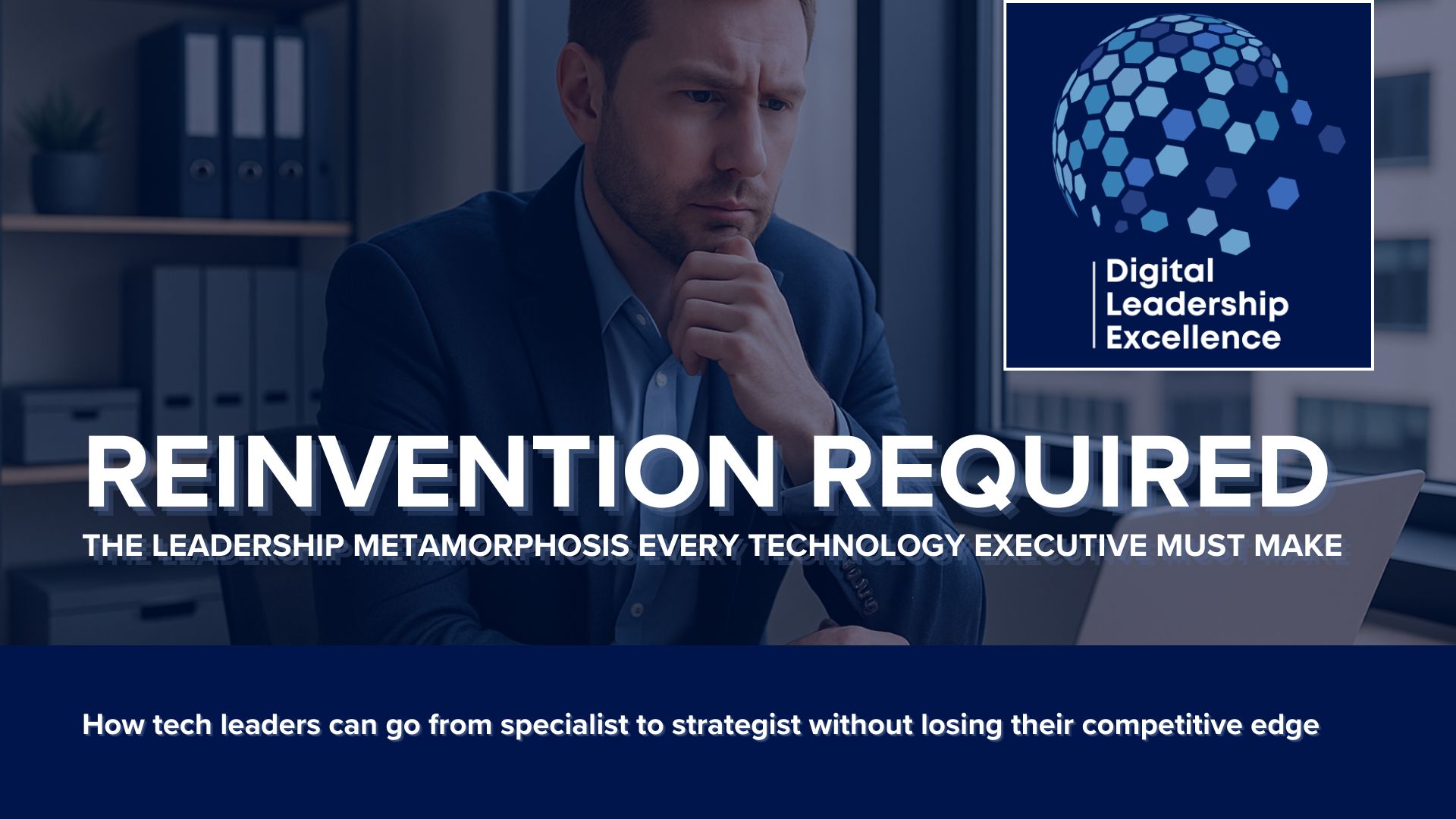- Digital Leadership Excellence
- Posts
- #56 Reinvention Required: The Leadership Metamorphosis every Technology Executive must make
#56 Reinvention Required: The Leadership Metamorphosis every Technology Executive must make
How tech leaders can go from specialist to strategist without losing their competitive edge

Greetings, and welcome to Digital Leadership Excellence — Your trusted weekly guide to excelling in tech leadership, delivering results, and thriving with clarity and purpose. In every issue, we provide insights into winning strategies, growth tactics, and practical solutions, designed to support both current and aspiring technology leaders navigating the ever-evolving digital world.
1.0 Introduction
You built your career on being the technical expert. Now that expertise feels like a prison.
Every technology leader faces this moment. The identity that brought you success starts limiting your advancement.
Here's why:
2.0 The Expert's Dilemma
Technical expertise creates a powerful professional identity. You become known as the person who solves complex problems, understands intricate systems, and delivers reliable solutions.
This identity works brilliantly for the first decade of your career. Technical competence plus consistent delivery equals steady promotion.
But at some point this approach stops working.

3.0 When Expertise Becomes a Ceiling
At executive levels, technical competence is assumed, not rewarded. Everyone at the VP table understands technology deeply. What separates executives from senior managers is business acumen, not technical mastery.
This creates an identity crisis for technology professionals:
Your confidence comes from technical knowledge. But executive decisions require business judgment.
Your credibility comes from being right about technical details. But leadership requires being strategically valuable even when you don't know every detail.
Your identity comes from solving technical problems. But executives shape business outcomes through people and processes.
Your value comes from individual technical contribution. But leaders create value through team capability and strategic direction.
4.0 The Metamorphosis Framework
The transition from technical specialist to business strategist isn't about abandoning your expertise. It's about transforming how you apply it.
Phase 1: Identity Expansion
Stop defining yourself by your technical function. Start defining yourself by your business impact.
Instead of: "I'm a Senior Software Architect"
Try: "I help companies scale their technology platforms to support rapid growth"
Instead of: "I manage the infrastructure team"
Try: "I ensure our technology foundation supports business continuity and competitive advantage"
Phase 2: Perspective Shift
Stop viewing business challenges as separate from technical challenges. Start seeing technology as the enabler of business strategy.
When leadership discusses market expansion, think about scalability requirements. When they analyze competitive threats, consider technology differentiation opportunities. When they evaluate customer acquisition costs, examine how technology can reduce friction.
Phase 3: Value Reframing
Stop leading with technical solutions. Start leading with business outcomes enabled by technology.
Poor approach: "We should implement microservices architecture to improve system modularity"
Strong approach: "We can reduce time-to-market by 40% while improving system reliability through modern architecture patterns"
Phase 4: Contribution Evolution
Stop being the person who has all the technical answers. Start being the person who asks the most strategically valuable technology questions.
Instead of: "Here's how we'll build that feature"
Ask: "What's the business case for this feature, and how does it support our strategic objectives?"
Instead of: "This technology choice is technically superior"
Ask: "Which technology approach best balances technical excellence with business timeline and resource constraints?"
5.0 The Four Identity Archetypes
Most technology leaders fall into one of four identity patterns:
The Technical Purist
Defines success by technical elegance and system performance. Struggles with business compromises and "good enough" solutions.
The Bridge Builder
Translates between technical and business teams but remains primarily technically focused.
The Strategic Technologist
Balances technical excellence with business impact. Comfortable in both technical and business discussions.
The Business-First Leader
Leads with business strategy while leveraging technical background for competitive advantage.
Executive advancement requires evolving from Purist or Bridge Builder to Strategic Technologist or Business-First Leader.

6.0 Why This Transformation Is So Difficult
Loss of Expertise Identity
Your technical mastery has been your source of confidence for years. Letting go feels like losing your professional identity.
Fear of Becoming Generic
You worry that focusing on business will make you just another generic leader without technical depth.
Imposter Syndrome
Business discussions where you're not the expert trigger anxiety about being exposed as inadequate.
Competence vs. Confidence
You're highly competent technically but lack confidence in business domains.
7.0 The Success Paradox
Here's what makes this transformation both necessary and painful: The very skills that made you successful become the skills that limit your advancement.
Your ability to dive deep into technical details becomes a tendency to get lost in implementation instead of focusing on strategy.
Your pride in technical excellence becomes perfectionism that slows decision-making.
Your confidence in technical domains becomes avoidance of business discussions where you feel less expert.

8.0 The Execution Playbook
Now let’s put this concept into action.
The EVOLVE Method
I've developed a six-step process for transforming your professional identity while maintaining your technical edge:
E - Expand Your Definition
V - Validate Business Impact
O - Observe Executive Patterns
L - Learn Business Language
V - Voice Strategic Perspectives
E - Establish New Metrics
Step 1: Expand Your Definition
Rewrite how you describe your role and value proposition.
Current Identity Audit: Write down how you currently introduce yourself and describe your work. Count how many technical terms vs. business terms you use.
Expanded Identity Creation: For every technical responsibility, identify the business outcome it enables.
Example Transformations:
Technical: "I design database architectures"
Business: "I create data foundations that enable real-time business intelligence and customer insights"
Technical: "I manage the DevOps pipeline"
Business: "I accelerate product delivery while ensuring quality and reliability that protects revenue"
Technical: "I lead the security team"
Business: "I protect company assets and customer trust while enabling secure business growth"
Step 2: Validate Business Impact
Connect every technical initiative to measurable business outcomes.
The Impact Translation Process:
Identify the technical work you're doing
Trace how it affects business operations
Quantify the business value created or protected
Communicate in business metrics
Example: Technical work: API performance optimization Business operation: Customer checkout process Business value: Reduced abandonment rate by 15%, protecting $2.3M annual revenue

Step 3: Observe Executive Patterns
Study how successful business leaders communicate and make decisions.
Executive Shadow Study: Attend business meetings as an observer.
Take note of the following
How do executives frame problems?
What questions do they ask first?
How do they evaluate options?
What language do they use?
What metrics do they reference?
Pattern Recognition:
They start with customer impact, not technical implementation
They ask about business risk before technical risk
They evaluate ROI before technical elegance
They discuss competitive advantage before system architecture
Step 4: Learn Business Language
Develop fluency in the concepts and terminology that drive business decisions.
Core Business Concepts for Technology Leaders:
Financial Metrics:
Revenue impact and protection
Cost reduction and avoidance
Return on investment and payback periods
Total cost of ownership
Strategic Concepts:
Competitive advantage and differentiation
Market positioning and customer acquisition
Operational efficiency and scalability
Risk mitigation and compliance
Customer Focus:
User experience and satisfaction
Customer lifetime value
Retention and churn rates
Market feedback and demands

Step 5: Voice Strategic Perspectives
Begin contributing to business discussions with technology-informed insights.
The Strategic Contribution Framework:
Lead with Business Context: "Our customer acquisition costs have increased 30% this quarter..."
Add Technical Insight: "The primary bottleneck is our onboarding flow, which requires 7 manual touchpoints..."
Propose Strategic Solution: "By automating the qualification process, we can reduce acquisition cost by 25% while improving conversion rates..."
Connect to Larger Strategy: "This aligns with our goal of becoming the most efficient platform in our market segment."
Step 6: Establish New Metrics
Measure success using business outcomes, not just technical performance.
Old Metrics:
System uptime percentage
Code quality scores
Deploy frequency
Technical debt reduction
New Metrics:
Revenue enabled or protected
Customer satisfaction improvement
Time-to-market acceleration
Competitive advantage creation

9.0 Real-World Application Scenarios
Scenario 1: Infrastructure Planning Meeting
Old Approach: "We need to upgrade our servers to handle increased load and improve response times."
New Approach: "Our customer growth is creating performance issues that could impact retention. Upgrading our infrastructure will support our 200% growth target while improving customer experience scores by an estimated 15%."
Scenario 2: Budget Discussion
Old Approach: "The security tools require annual licensing renewal and additional staff training."
New Approach: "This security investment protects us against the $4.2M average cost of data breaches in our industry while enabling our expansion into regulated markets worth $50M in potential revenue."
Scenario 3: Strategic Planning Session
Old Approach: Stay quiet during business strategy discussion, only speaking when asked about technical feasibility.
New Approach: "This market expansion strategy could be accelerated by leveraging our API architecture to enable rapid partner integrations, potentially reducing our go-to-market timeline from 12 months to 6 months."
10.0 The 90-Day Transformation Plan
Days 1-30: Identity Foundation
Rewrite your role description in business terms
Practice introducing yourself with business impact focus
Attend 3 business meetings as an observer
Days 31-60: Language Development
Learn one new business concept per week
Translate 5 technical projects into business impact statements
Contribute one business perspective in team meetings
Days 61-90: Strategic Integration
Lead one business discussion using technology insights
Present a technical proposal in pure business terms
Establish new success metrics for your role

Common Transformation Challenges
Challenge 1: Technical Perfectionism
Business decisions often require "good enough" solutions that technical perfectionists resist.
Solution: Focus on business optimization rather than technical optimization.
Challenge 2: Expertise Anxiety
Fear of not being the smartest person in business discussions.
Solution: Position yourself as the person who brings technical reality to business strategy.
Challenge 3: Identity Loss
Worry that business focus diminishes technical credibility.
Solution: Frame technical expertise as your competitive advantage in business leadership.

Measuring Transformation Success
You'll know you've successfully transformed when:
People seek your opinion on business strategy, not just technical implementation
You're invited to participate in market and competitive analysis discussions
Your project proposals are evaluated on business merit, not just technical merit
Other executives view you as a business partner who happens to understand technology deeply
11.0 The Leadership Metamorphosis
This transformation isn't about becoming less technical. It's about becoming more strategically valuable.
Your technical foundation becomes your differentiator in business leadership.
Your expertise becomes the lens through which you evaluate business opportunities.
Your experience becomes the credibility that makes your strategic insights valuable.
Your Next Steps
This week: Rewrite your LinkedIn profile to emphasize business impact over technical functions.
Next week: Contribute one technology-informed perspective to a business strategy discussion.
This month: Present one technical initiative using pure business justification.
The Bottom Line
Reinvention isn't optional for technology leaders who want executive influence. It's required.
The metamorphosis from technical specialist to business strategist determines your career trajectory.
Nail this transformation, and you will have truly mastered executive leadership.
Robert
P.S. - The hardest part about reinvention isn't learning new skills. It's letting go of the identity that no longer serves your advancement. Growth requires becoming someone you've never been before.

Robert Castle
Founder | DIGITAL LEADERSHIP EXCELLENCE
What did you think of today’s Newsletter?select below |
Reply